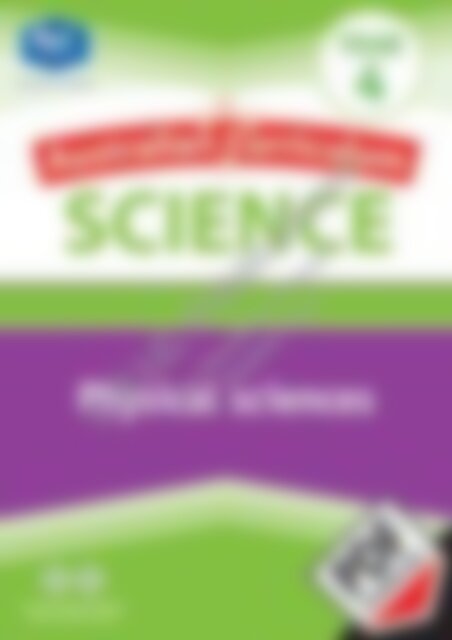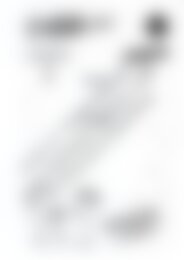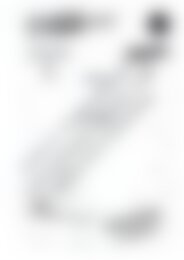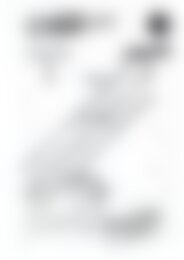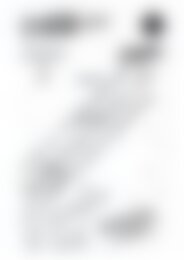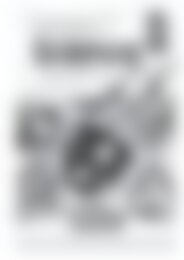20040 AC Science Year 4 Physical sciences
You also want an ePaper? Increase the reach of your titles
YUMPU automatically turns print PDFs into web optimized ePapers that Google loves.
Your partner in education<br />
YEAR<br />
4<br />
<strong>Physical</strong> <strong>sciences</strong><br />
YEAR 1<br />
SCIENCE<br />
©R.I.C. Publications<br />
Low Resolution Images<br />
Display Copy<br />
Australian Primary Publisher<br />
of the <strong>Year</strong> 2015 and 2016
Australian Curriculum <strong>Science</strong> (<strong>Year</strong> 4)<br />
Published by R.I.C. Publications ® 2011<br />
Copyright© R.I.C. Publications ® 2011<br />
Revised 2017<br />
RIC-<strong>20040</strong><br />
Titles in this series:<br />
Australian Curriculum <strong>Science</strong> (Foundation)<br />
Australian Curriculum <strong>Science</strong> (<strong>Year</strong> 1)<br />
Australian Curriculum <strong>Science</strong> (<strong>Year</strong> 2)<br />
Australian Curriculum <strong>Science</strong> (<strong>Year</strong> 3)<br />
Australian Curriculum <strong>Science</strong> (<strong>Year</strong> 4)<br />
Australian Curriculum <strong>Science</strong> (<strong>Year</strong> 5)<br />
Australian Curriculum <strong>Science</strong> (<strong>Year</strong> 6)<br />
Australian Curriculum <strong>Science</strong> (<strong>Year</strong> 7)<br />
All material identified by O is material subject to copyright<br />
under the Copyright Act 1968 (Cth) and is owned by the Australian<br />
Curriculum, Assessment and Reporting Authority 2017.<br />
For all Australian Curriculum material except elaborations: This is<br />
an extract from the Australian Curriculum.<br />
Elaborations: This may be a modified extract from the Australian<br />
Curriculum and may include the work of other authors.<br />
Disclaimer: <strong>AC</strong>ARA neither endorses nor verifies the accuracy<br />
of the information provided and accepts no responsibility for<br />
incomplete or inaccurate information.<br />
In particular, <strong>AC</strong>ARA does not endorse or verify that:<br />
• The content descriptions are solely for a particular year and<br />
subject;<br />
• All the content descriptions for that year and subject have been<br />
used;and<br />
• The author's material aligns with the Australian Curriculum<br />
content descriptions for the relevant year and subject.<br />
You can find the unaltered and most up to date version of this<br />
material at http://www.australiancurriculum.edu.au/<br />
This material is reproduced with the permission of <strong>AC</strong>ARA.<br />
Cft<br />
I Australian<br />
gw CURRICULUM<br />
Copyright Notice<br />
A number of pages in this book are worksheets.<br />
The publisher licenses the individual teacher<br />
who purchased this book to photocopy these<br />
pages to hand out to students in their own<br />
classes.<br />
Except as allowed under the Copyright Act 1968,<br />
any other use (including digital and online uses<br />
and the creation of overhead transparencies<br />
or posters) or any use by or for other people<br />
(including by or for other teachers, students or<br />
institutions) is prohibited. If you want a licence<br />
to do anything outside the scope of the BLM<br />
licence above, please contact the Publisher.<br />
This information is provided to clarify the limits<br />
of this licence and its interaction with the<br />
Copyright Act.<br />
For your added protection in the case of<br />
copyright inspection, please complete the form<br />
below. Retain this form, the complete original<br />
document and the invoice or receipt as proof<br />
of purchase.<br />
Name of Purchaser:<br />
Date of Purchase:<br />
Supplier:<br />
School Order# (if applicable):<br />
Signature of Purchaser:<br />
©R.I.C. Publications<br />
Low Resolution Images<br />
Display Copy<br />
Internet websites<br />
In some instances, websites or specific URLs may be recommended. While these are checked and rechecked at the time of<br />
publication, the publisher has no control over anysubsequentchangeswhich may be madetowebpages. ltis stronglyrecommended<br />
that the class teacher checks all UR Ls before allowing students to access them.<br />
View all pages online<br />
PO Box 332 Greenwood Western Australia 6924<br />
Website: www.ricpublications.com.au<br />
Email: mail@ricpublications.com.au<br />
R.I.C. PUBLICATIONS<br />
YOUR PARTNER IN EDUCATION<br />
AUSTRALIAN<br />
PRIMARY PUBLISHER<br />
OF THE YEAR<br />
2015 AND 2016
Foreword<br />
Australian Curriculum <strong>Science</strong> Foundation to <strong>Year</strong> 7 is a series of books written specifically to support the national curriculum. <strong>Science</strong><br />
l i teracy texts introduce concepts and are supported by practical hands-on activities, predominantly experiments.<br />
All <strong>Science</strong> Understanding and <strong>Science</strong> as a Human Endeavour substrands for each level are included. <strong>Science</strong> Inquiry Skills and overarching ideas<br />
underpin all topics.<br />
Titles in this series are:<br />
Australian Curriculum <strong>Science</strong> - Foundation<br />
Australian Curriculum <strong>Science</strong> - <strong>Year</strong> 1<br />
Australian Curriculum <strong>Science</strong> - <strong>Year</strong> 2<br />
Australian Curriculum <strong>Science</strong> - <strong>Year</strong> 3<br />
Australian Curriculum <strong>Science</strong> - <strong>Year</strong> 4<br />
Australian Curriculum <strong>Science</strong> - <strong>Year</strong> 5<br />
Australian Curriculum <strong>Science</strong> - <strong>Year</strong> 6<br />
Australian Curriculum <strong>Science</strong> - <strong>Year</strong> 7<br />
Contents<br />
Teachers notes ................................................................. iv - vi What are materials scientists? ........................................... 46-48<br />
Scope and sequence ................................................................ vii Inventions and devices research ............................................. 49<br />
Report format ........................................................................ viii<br />
Basic experiment format ......................................................... ix<br />
Earth and space <strong>sciences</strong> .............................................. 50-65<br />
What is weathering? .......................................................... 50--52<br />
Biological <strong>sciences</strong> ......................................................... 2-33 Weathering investigations ....................................................... 53<br />
What is the life cycle of a sunflower? .................................... 2-4<br />
Where does soil come from? ............................................ 54--56<br />
Bean seeds experiment ............................................................ 5 Soil testing experiment ........................................................... 57<br />
What is the life cycle of a frog? ............................................. 6--8<br />
What is erosion? ............................................................... 58--60<br />
Amphibian report ..................................................................... 9 Extreme weather research project.. ........................................ 61<br />
What is the life cycle of an elepha n t? ................................ 10-12 How do farming practices affect erosion? ......................... 62-64<br />
Mammal life cycle quiz ........................................................... 13 Plants and erosion experiment ............................................... 65<br />
How does environment affect life cycles? .......................... 14-16<br />
Ladybug life cycle wheel... ...................................................... 17<br />
How do living things get energy to live? ............................ 18-20<br />
What happens when plants are no longer living? .................... 21<br />
Why do living things in a habitat interact? ......................... 22-24<br />
Researching symbiosis ........................................................... 25<br />
What are food chains? ...................................................... 26-28<br />
Observational report .............................................................. 29<br />
Why are living things endangered? .................................... 30-32<br />
Endangered living thing report ............................................... 33<br />
<strong>Physical</strong> <strong>sciences</strong> .......................................................... 66-81<br />
How are objects moved by forces? .................................... 66-68<br />
©R.I.C. Publications<br />
Low Resolution Images<br />
Display Copy<br />
Pushing and pulling experiments ........................................... 69<br />
How do forces change movement and speed? ................... 70--72<br />
Force and distance ................................................................. 73<br />
What are magnets? How do they work? ............................. 74--76<br />
What does a magnetic field look like? ..................................... 77<br />
What is friction? ............................................................... 78-80<br />
Testing friction ....................................................................... 81<br />
Chemical <strong>sciences</strong> ........................................................ 34-49<br />
What properties do materials have? .................................. 34-36<br />
Testing! Testing! 1, 2, 3 ,4!...................................................... 37<br />
Why search for new materials? ......................................... 38-40<br />
Can you make a material stronger? ......................................... 41<br />
What is insulation? ........................................................... 42-44<br />
The best thermal insulators and conductors ........................... 45<br />
m<br />
R.I.C. Publications ® www.ricpublications.com.au AUSTRALIAN<br />
CURRICULUM SCIENCE (<strong>Year</strong> 4)
Teachers notes<br />
Each book is divided into four sections corresponding to the four substrands of the <strong>Science</strong> Understanding strand of the curriculum. Shaded tabs<br />
down the side of each book provide a quick and easy means to locate biological <strong>sciences</strong>, chemical <strong>sciences</strong>, Earth and space <strong>sciences</strong> or physical<br />
<strong>sciences</strong> substrands.<br />
<strong>Science</strong> as a Human Endeavour units or questions, as set out in the Australian Curriculum, are included in all substrands.<br />
<strong>Science</strong> Inquiry Skills are included in all units. The skills utilised are listed on each teachers page.<br />
The six overarching ideas (Patterns, order and organisation; Form and function; Stability and change; Scale and measurement; Matter and energy; and<br />
Systems) underpin each science literacy text page and are included as much as possible throughout the comprehension pages.<br />
Each substrand is divided into a number of four-page units, each covering a particular aspect and following a consistent fonnat.<br />
The four-page fonnat of each unit consists of:<br />
• a teachers page<br />
• student page 1, which is a science literacy text about the concept with relevant diagrams or artwork<br />
• student page 2, which includes comprehension questions about the literacy text<br />
• student page 3, which involves a hands-on activity such as an experiment.<br />
FOUR-PAGE FORMAT<br />
Teachers page<br />
The first page in each four-page fonnat is a teachers page which provides the following infon n ation:<br />
• A shaded tab gives the<br />
<strong>Science</strong> Understanding<br />
sub strand.<br />
• The title of the four-page<br />
un i t is given.<br />
• The content focus (the<br />
particular aspect of the unit<br />
covered in that set of four<br />
pages) is given.<br />
• The inquiry skills covered<br />
w i thin the four pages is set out.<br />
What Is the life cycle of an elephant?<br />
Ufeqdeofamamml<br />
, .. u-y.m.: Quesdom!g aod pml!c!ing<br />
-<br />
---t--.-,....,....,,ortheintemet<br />
Pbmng:iodcomwlng<br />
Processingmdgduand<br />
iliocmation<br />
Comn<br />
·eofelep<br />
).Thefirst<br />
lo lhe:mswml o thequ<br />
African,Afria.alore;tmd.Amn<br />
f'Jllii:medlstklup.<br />
needlObeavahbleforswdenls<br />
oopa ge I.<br />
• Som euseful1'tllsltesforanswerspagcl3Jachide;<br />
- ,:iq>Jllin)Url.comld3dyml><br />
- .:bnpJ/Un)'llrl,com,,bmcvb2><br />
- <br />
• l'age&llandl2i!houldbek)gdher.<br />
• BraioslonnquesliooslO glddcstudcr.lS're5eatci.Sti.ldrotschoosc<br />
sixquest!ons toaoswerb:thelhreellllllll<br />
• DiscussTIIWllllsuchas'lilecyde',·adol.eslt'111d'matriarcll'<br />
• 'tlldmts shal'.e their l'.ep(lrts ud rulea oa the depth of knowledge<br />
th eyhave showA.<br />
hge12<br />
I. Posslble answcrs :gi.vcblnkiolhic)(Ul&'blaycgp(r:ueptfor<br />
moootreme5-us md edlkba),feed tllel.f }tlWl8 milk/mosdy<br />
hlmthrecmaloSt:agC!lollfcqde'lookahcrll!ldLtaclithdryoUII@<br />
2. Answensbowdlndi.caxetltalitlalleSk>fababy elephmtto<br />
growinsldethemotherbeause it ls so1111Jdibiggel'lhan adogand<br />
morederelopedalbirlhtu.Da<br />
3.(a)It must5llludup<br />
(bl So lt caodrlokit smothenrmlkmdMlk1'11htheherd!n the<br />
wild.<br />
4. Theyteachittouse itstrunklorlftlCiogainkmgv.iterandbathing<br />
5. 'Whenitstopsdrinkingmilkmirely:iodea!SOD)'vegdlllin;between<br />
j)<br />
Sandtoyeusold.<br />
6.Posslble answers:youn,gbuilsplay.fighlltullsle:M:thehcrdand<br />
cows sraylrilhlheherd<br />
Sdena:uaHumanl!ndn.vuaripeslloo<br />
--<br />
Natrneandtkvek>pmof 1Ciena<br />
<br />
Teacbercbeck<br />
,..,,13<br />
• The lessons provides<br />
infonnation relating to<br />
implementing the lessons on<br />
the following student pages.<br />
• Answers and explanations are<br />
provided where appropriate<br />
for student pages 2 and 3 (the<br />
comprehension questions<br />
relating to the text and the final<br />
activity in the set of four pages).<br />
©R.I.C. Publications<br />
Low Resolution Images<br />
Display Copy<br />
• Background information, ------1------<br />
which includes additional<br />
information for teacher and 1 -'1 x1' 111 !i 1·11• 1 1i f·' 1i::ft:M1iiliffi-0 +:...' !i3 . ,<br />
student use and useful websites<br />
relating to the topic of the<br />
section, expands on the unit.<br />
• Preparation states any<br />
material or resources the<br />
teacher may need to collect to<br />
implement a lesson, or carry<br />
out an experiment or activity.<br />
AUSTRALIAN CURRICULUM SCIENCE (<strong>Year</strong> 4)<br />
-<br />
www.ricpublications.com.au R.I.C. Publications ®
·<br />
'<br />
Teachers notes<br />
FOUR-PAGE FORMAT (continued)<br />
Student page 1<br />
The second page in the four-page format is a science literacy text which introduces the topic. This page provides the following infonnation:<br />
• A shaded tab down the side gives the <strong>Science</strong> -<br />
Understanding substrand.<br />
- <br />
,......<br />
• The title of the unit is given. This is in the fonn of<br />
a question to incorporate science inquiry skills and<br />
overarching ideas.<br />
• Instructions are given for reading the text.<br />
• The science literacy text is provided.<br />
• Relevant diagrams or artwork enhance the text, ,<br />
or are used to assist student understanding of the<br />
concepts.<br />
Student page 2<br />
W _h_ _t-is- t h_ _ l_i_ _ c _<br />
a e e<br />
y c _ l _ _<br />
o f _ _ _ n _ _l _<br />
e a e e<br />
p _h_ _n t _ ?- . --- 1 --- a<br />
1<br />
Read the text.<br />
An elephant Is the largest Wving land mammal. Mammals give birth to live young,<br />
Instead of laying eggs as many onlmols, such as birds, reptiles and Insects,<br />
1 e<br />
::;::r ! e :':tog: °:;'!1/e':;:e .:<br />
odolescent--adult.<br />
Baby<br />
A baby elephant, called a coif, develops inside its mother for 22 months. Thot<br />
is the longest time for any land animal to be pregnant! Among other mammals.<br />
humans are pregnant for 9 months, whle a dog is pregnant for only 9 weeks.<br />
A female elephant, called a cow, usuolly gives birth to only one calf at a time. A<br />
newborn calf has ginger coloured hoir over its hood and back. It loses this as i1<br />
grows oldar.Itsmother usesher lrunk to help the<br />
newborn stand up. The catr must do this right away<br />
·- .;_<br />
ca c<br />
1<br />
ild,<br />
a: n"e;: ii: v-4:::r :; ,' ·' . ·;<br />
<br />
o<br />
r o<br />
:y tih n<br />
::== o t: r '_i :•' :J\,L:<br />
litres of milk ooch doy. After it grows too1ti, ot obout 3 ,' ,· :<br />
years of age, it starts to eat grass and other vegerotion.<br />
The calfs molher and the other adult females in the herd help look aner ii. The<br />
coif learns how to use its trunk for feeding, ckinking water and bathing.<br />
Adolescent<br />
An elephant is called an adolescenl when it stops drinking milk entirely and eols<br />
only vegetation. This happens between 5 and IO years of age.<br />
Male elephants are coiled bulls. Young<br />
buls play-fight by charging each other and<br />
maki'lg a lot of trumpeting noises wilh lheir<br />
: Y h<br />
o::i : ;!;<br />
Olher young bulls.<br />
Female elephants, the cows, stoy wilh the herd all their ves. The herd is ruled by<br />
tt,e oldest female, coiled the matria1ch .<br />
Adult<br />
AA elephant is an adult at about 18 yeors of oge. Male and female elephants<br />
begin to mate at about 20 years d age. A cow will hove six or seven calves during<br />
her lif e time. She stops having calves at about 50 years of age. An elephant con<br />
live untl it is abaut70.<br />
The second student page consists of a series of questions or activities relating to the literacy text. They aim to gauge student understanding of the<br />
concepts presented in the text. Many of these questions relate to overarching ideas relevant to that age level as stated in the Australian Curriculum<br />
<strong>Science</strong>.<br />
IWhat Is the life cycle of on elephant? - 2<br />
Use the text on page I I to complata the following.<br />
I. What ore two chorocleristics mammals hove in common?<br />
dog for only 9 weeks?<br />
2. Why do you think o female elephant is pregnant for 22 months and o<br />
3. (a) What must o newborn coif do os soon as it is born?<br />
• The title, which is the same as the text page, is given.<br />
• A shaded tab gives the <strong>Science</strong> Understanding substrand.<br />
©R.I.C. Publications<br />
Low Resolution Images<br />
Display Copy<br />
. .,.,,,<br />
'<br />
(b) Why must it be able lo do this?<br />
If. What skills do the mother and other herd members teach a coif?<br />
• Questions or activities follow. These relate to the text on<br />
the previous page.<br />
P1<br />
------------<br />
5. When does on elephonl beoome on adolescent?<br />
6. Describe one difference between the life<br />
of a bull and a cow.<br />
Cc<br />
<br />
Visit this website lo dislXJver facts zoologists have discovet about the<br />
uses of on elephanfs trunk.<br />
Teachers notes<br />
FOUR-PAGE FORMAT (continued)<br />
Student page 3<br />
The third student page provides a hands-on activ i ty. It may be an experiment, art or craft activity, research activity or similar.<br />
• A shaded tab gives the <strong>Science</strong> Understanding<br />
subst r and.<br />
• The title is given. This will be different from the<br />
previous two pages, but will be a related to the<br />
concept focus of the unit.<br />
• An adapted procedure for an experiment, craft<br />
activity or a research activity is given.<br />
<strong>Science</strong> as a Human Endeavour units and questions<br />
--·---,··-<br />
Each fX the animals below is a mommol. Write six questions to research and<br />
---+-- Mammal life cycle quiz<br />
·'H'l: 1 11<br />
Those four-page units which are related specifically to <strong>Science</strong> as a Human Endeavour subst r ands are indicated by the icon shown.<br />
Where <strong>Science</strong> as a Human Endeavour questions occur within <strong>Science</strong> Understanding units, they are also indicated by the use of the<br />
icon. Explanations and answers relating to these questions are given on the appropriate teachers page.<br />
©R.I.C. Publications<br />
Low Resolution Images<br />
Display Copy<br />
I ..<br />
AUSTRALIAN CURRICULUM SCIENCE (<strong>Year</strong> 4)<br />
m<br />
www.ricpublications.com.au<br />
R.I.C. Publications ®
(t, JeaA) :l:JN:11:JS Wn1n:JIUHn:J ffltl1l'111SnY<br />
<br />
'<br />
'<br />
'<br />
'<br />
'<br />
'<br />
<strong>Physical</strong><br />
<strong>sciences</strong><br />
ti?<br />
---J ---J<br />
---J u,<br />
' '<br />
•<br />
' '<br />
' '<br />
'<br />
'<br />
' '<br />
' '<br />
t<br />
'<br />
'<br />
Earth and space<br />
<strong>sciences</strong><br />
V,<br />
a-- °'<br />
v, -<br />
a--'i" 'l"<br />
I<br />
' '<br />
'<br />
'<br />
,1,<br />
' '<br />
---J<br />
©R.I.C. Publications<br />
Low Resolution Images<br />
Display Copy<br />
V,<br />
' '<br />
• '<br />
• '<br />
'<br />
' ' '<br />
' ' ' '<br />
' '<br />
' ' ' ' '<br />
' ' ' '<br />
t<br />
'<br />
'<br />
'<br />
'<br />
'<br />
Chemical<br />
<strong>sciences</strong><br />
tll<br />
' '<br />
'<br />
'<br />
' '<br />
---J<br />
'<br />
'<br />
u,<br />
u,<br />
' '<br />
'<br />
' '<br />
...,<br />
V,<br />
'<br />
m<br />
ne·woo·suO!tBO!IQndO!J"MMM<br />
•<br />
'<br />
Biological<br />
<strong>sciences</strong><br />
---J<br />
' '<br />
' '<br />
!<br />
u,<br />
' '<br />
• • •<br />
' '<br />
,1,1,1,1,1,1,1,1,<br />
' ' '<br />
' ' ' ' ' ' ' ' ' '<br />
' ' ' ' ' '<br />
' ' ' ' ' ' ' ' ' '<br />
' ' ' ' ' ' ' ' ' '<br />
•<br />
ois- :::C ro·<br />
..., 1-=<br />
J, rfcl = "' § -· = ::, g•<br />
!l<br />
'<br />
a,SUO!lBO!IQnd ":JTII<br />
.gs·<br />
5'q9.. c:i.. s<br />
[<br />
<br />
(<strong>AC</strong>SSU076)<br />
0<br />
<strong>Science</strong> involves making predictions and<br />
• describing patterns ond relationships<br />
0<br />
<strong>Science</strong> knowledge helps people to understand<br />
•<br />
the effect of their actions (<strong>AC</strong>SHE062)<br />
0<br />
'<br />
'<br />
'<br />
'<br />
'<br />
Living things have life cycles (<strong>AC</strong>SSU072<br />
e<br />
Living things depend on eoch other and<br />
the environment to survive (<strong>AC</strong>SSU073)<br />
0<br />
Natural and processed materials have o range of<br />
physical properties that con influence their use<br />
(<strong>AC</strong>CSSU074)<br />
0<br />
Earth's surtoce changes over time as a result of<br />
natural processes and human activity<br />
(<strong>AC</strong>SSU075)<br />
0<br />
Forces can be exerted by one object on another<br />
through direct contact or from a distance<br />
(<strong>AC</strong>SHE061)<br />
With guidance, identity questions in familiar<br />
contexts that can be investigated scientifically<br />
and make predictions bosed on their prior<br />
knowledge (<strong>AC</strong>SIS064)<br />
With guidance, pion and conduct scientific<br />
investigations to find answers to questions,<br />
considering the safe use of appropriate<br />
moteriols and equipment (<strong>AC</strong>SIS065) o<br />
0<br />
Consider the elements of fair tests and use<br />
formal measurements and digital technologies<br />
as appropriate, to make and record observations<br />
accurately (<strong>AC</strong>SIS066)<br />
0<br />
Use a range of methods including tables and<br />
simple column graphs to represent data and to<br />
identity patterns and trends (<strong>AC</strong>SIS068)<br />
0<br />
Compare results with predictions, suggesting<br />
possible reasons for findings (<strong>AC</strong>S!S216)<br />
0<br />
Reflect on investigations. including whether a<br />
test was fair or not (<strong>AC</strong>SIS069)<br />
0<br />
Represent and communicate observations,<br />
ideas and findings using formal and informal<br />
representations ( <strong>AC</strong>S!S071)<br />
0<br />
{ .. JDaA) aouanbas puo acloos<br />
n o. n<br />
0 n, 0<br />
< =<br />
"' n -<br />
g_.g- a<br />
' .... <br />
S?.<br />
e..<br />
0<br />
qg_<br />
i·<br />
CJ><br />
CJ> c:"'l<br />
- <br />
§ [<br />
CJ> t'rj<br />
- = st-e;<br />
§<br />
CJ> ...,<br />
Cl. =--<br />
::,..<br />
gl_<br />
(') (')<br />
a<br />
g, <br />
e<br />
rn· <br />
§<br />
n:, a Q..<br />
- <br />
§<br />
(I) (I) ::,..<br />
g,<br />
CJ> g; C:<br />
§<br />
::,.. ,0 =<br />
'"Cl (I)<br />
'"' CJ><br />
e, o<br />
(') s.<br />
(I) i:,-.<br />
i:,-.<br />
::, ao<br />
ao<br />
8.<br />
::,<br />
ao<br />
§<br />
::,..<br />
g-<br />
ao<br />
r[<br />
§ s·<br />
::,.. ao<br />
g: §<br />
0 ::,..<br />
<br />
g-<br />
§_<br />
= s·<br />
ao<br />
J<br />
g-<br />
ao<br />
<br />
§<br />
-<br />
g<br />
OQ<br />
<br />
i<br />
IYQ<br />
<br />
i;·<br />
=- = " = t'rj<br />
t'I)<br />
<br />
ail Ill<br />
ij f<br />
<br />
<br />
I <br />
Reort format<br />
--------------<br />
Title<br />
Classification<br />
What is it?<br />
Description<br />
©R.I.C. Publications<br />
Low Resolution Images<br />
Display Copy<br />
Conclusion<br />
What I think about it.<br />
AUSTRALIAN CURRICULUM SCIENCE (<strong>Year</strong> 4)<br />
m<br />
www.ricpublications.com.au<br />
R.I.C. Publications ®
______ E_xeriment format<br />
Title<br />
Goal<br />
Materials<br />
Steps<br />
Results<br />
©R.I.C. Publications<br />
Low Resolution Images<br />
Display Copy<br />
Conclusion<br />
R.I.C. Publications ® www.ricpublications.com.au<br />
m<br />
AUSTRALIAN<br />
CURRICULUM SCIENCE (<strong>Year</strong> 4)
How are objects moved by forces?<br />
Content focus: Definition of forces and how forces<br />
make things move<br />
Inquiry skills: Questioning and predicting<br />
Planning and conducting<br />
Processing and analysing data and<br />
information<br />
Evaluating<br />
Communicating<br />
Background information<br />
• The measurement of force-the Newton-is named after Sir Isaac<br />
Newton.<br />
• Sir Isaac Newton developed a series of laws of motion. His first law<br />
states t h at an object in motion tends to keep going at the same speed<br />
and in the same direction unless something exerts a force on it.<br />
However, objects do not keep moving forever. This is due to a force<br />
called friction that stops moving objects.<br />
• 1\vo forces are involved when a ball bounces. That is the force of<br />
the ball pushing on the floor and the force of the floor pushing on<br />
the ball. This is Newton's third law that states that every action has a<br />
reaction. Substances like the material a ball is made from can stretch<br />
because long flexible molecules bend and stretch.<br />
• Gravity is an invisible force that is applied at a distance. Because the<br />
Earth is the greatest mass its force is stronger but forces are in pairs<br />
- an action and a reaction.<br />
• The oceans move in response to the moon's force of gravity. The<br />
ocean's tides are caused by the moon's grav i ty trying to 'pull'<br />
anything on Earth towards it, but only the water is affected as it is<br />
always moving. Each day, as the oceans rise and fall, there are two<br />
high tides and two low tides.<br />
• The website has a very simple game for<br />
students to play to use different pushes and pulls, sizes of objects,<br />
and gradients to see how far objects move.<br />
Preparation<br />
• As a class, find and discuss different objects in the classroom, in the<br />
playground or at home which require a 'push' or a 'pull' to make<br />
them work. Examples may include pushing or pulling a door to open<br />
it, pencils which require both a push and a pull to work etc.<br />
The lessons<br />
• Pages 67 and 68 should be used together.<br />
• Allow the students to read the text on page 67 independently. Assist<br />
them w i th any unfamiliar vocabulary if necessary, then discuss the<br />
information and concepts.<br />
• Students may need to work in pairs to set up the experiments on<br />
page 69. As with all experiments, discuss after completion to reflect<br />
on what worked well ( or not very well), and any improvements<br />
which could be made to obtain a better, or different, result if it was<br />
repeated.<br />
Answers<br />
Page68<br />
1. pushing, pulling, lifting, stretching, twisting, spinning<br />
2. (a) True (b) False<br />
(c) False (d) False<br />
3. (a) directly (b) less<br />
4. (a) Answers should indicate: It is the energy stored in a squashed<br />
ball that is released and causes the ball to bounce back.<br />
5. Answers will vary but will be similar to: A balanced force is one in<br />
which forces of the same size act in opposite directions.<br />
6. (a)<br />
(b)<br />
(c)<br />
©R.I.C. Publications<br />
Low Resolution Images<br />
Display Copy<br />
Page69<br />
PUSH experiment: Teacher check answers. The air in the balloon<br />
provides a forces which pushes it and makes it move.<br />
PUU experiment: Teacher check answers. The weight of the marbles<br />
in the bucket creates a pulling force on the rubber band making it<br />
stretch and become longer.<br />
AUSTRALIAN CURRICULUM SCIENCE (<strong>Year</strong> 4)<br />
m<br />
www.ricpublications.com.au<br />
R.I.C. Publications ®
How are objects moved by forces? - I<br />
Read the text.<br />
Objects cannot move by themselves. They need some kind of force to make them<br />
move. Forces cause objects to speed up, slow down or change direction. The<br />
greater the mass of an object, the more force is needed to start or stop it moving.<br />
An object can be made to move by pushing, pulling, lifting, stretching, twisting or<br />
spinning forces acting on it.<br />
Forces move in a particular direction and are usually shown on a diagram with<br />
arrows. The arrows show the direction in which the force is acting.<br />
Forces such as pushes, pulls and collisions are applied directly and transfer<br />
energy to an object. When a ball is kicked, energy from the foot is transferred to<br />
the ball, sending it in the direction and at the speed the player wants. When you<br />
throw a ball, a similar transfer of energy from your arm to the ball occurs.<br />
Some substances can be stretched or squeezed when a force is used to pull or<br />
push them. But these substances spring back into their original shape when the<br />
force is removed. Many balls are made from materials that stretch like this. So<br />
when a ball hits a wall, it is squashed a bit then it springs back into shape. As it<br />
springs back, the energy stored in the squashed ball is released. This is the force<br />
that causes the ball to bounce back again.<br />
Friction is another directly applied force. A rolling ball would continue to roll along<br />
without stopping if it wasn't for the force of friction acting on it. A ball rolling along<br />
a rough surface slows down and stops quicker than one rolling along a smooth<br />
surface. This is because the force of friction between the two surfaces is greater.<br />
Gravity is a natural force, exerted from a distance, which causes a mass to attract<br />
and be attracted by any other mass. Because the Earth has the greatest mass, all<br />
other objects with a smaller mass are pulled downwards towards it. The famous<br />
scientist Sir Isaac Newton used the example of an apple dropping from a tree and<br />
falling to the ground, to explain this theory. Objects have weight on Earth because<br />
gravity pulls them down.<br />
Forces are said to be balanced (or equal) if they are the same size but acting<br />
in opposite directions. If balanced forces are acting on an object, the object will<br />
not change its motion. If it is still, it will remain still. If it is moving, it will continue<br />
moving in the same direction and at the same speed. Unbalanced forces change<br />
the way an object is moving by making objects start to move, speed up, slow<br />
down, or change direction.<br />
R.I.C. Publications ® www.ricpublications.com.au<br />
m<br />
©R.I.C. Publications<br />
Low Resolution Images<br />
Display Copy<br />
AUSTRALIAN<br />
CURRICULUM SCIENCE (<strong>Year</strong> 4)
How are objects moved by forces? -2<br />
Use the text on page 67 to complete the following.<br />
I. What are six common ways forces can move an object?<br />
2. Which statements are True or False?<br />
(a) An object with a greater mass needs more force to move it.<br />
(b) Objects move in the opposite direction to the force being exerted on them.<br />
(c) An apple falling from a tree is an example of friction.<br />
(d) The greater the pull of gravity, the less an object weighs.<br />
3. (a) Is friction a force that is applied directly or at a distance? ______ _<br />
(b) Is friction greater or less between smooth surfaces? _______ _<br />
4. Explain the force that causes a ball to bounce.<br />
5. Explain what a balanced force is.<br />
6. Draw an arrow to show the direction of the force being applied by people in<br />
each picture.<br />
(a)<br />
©R.I.C. Publications<br />
Low Resolution Images<br />
Display Copy<br />
(b)<br />
(c)<br />
AUSTRALIAN CURRICULUM SCIENCE (<strong>Year</strong> 4)<br />
m<br />
www.ricpublications.com.au<br />
R.I.C. Publications ®
Pushing and pulling experiments<br />
Complete the following experiments to find out about forces.<br />
Materials:<br />
Balloon rocket push<br />
• balloon • drinking straw • scissors<br />
• fishing line/cotton about 4-5 m long<br />
• 2 chairs • masking tape<br />
I. Steps:<br />
O Thread<br />
fishing line<br />
through straw.<br />
f) Place chairs about 4 m<br />
apart and tightly tie fishing line<br />
between chairs.<br />
E) Move straw to one end of line.<br />
O Blow up balloon and twist open<br />
end to seal.<br />
C, Tape inflated balloon to straw.<br />
8 Release neck of balloon.<br />
2. Predict what will happen to the<br />
balloon.<br />
3. Write the results and an explanation<br />
(or analysis) for what happened.<br />
Materials:<br />
Rubber band weight pull<br />
• long ruler or length<br />
of wood • pencil<br />
• 2 tables<br />
• strong rubber band<br />
• paper strips • small plastic bucket<br />
• strong wire • marbles<br />
• scissors<br />
I. Steps:<br />
O Attach wire to bucket handle to<br />
form hook.<br />
f) Slip rubber band over wood to<br />
middle.<br />
E) Place wood between tables.<br />
O Attach hook to rubber band to<br />
suspend bucket.<br />
C, Cut strip of paper the same<br />
length as rubber band (with<br />
bucket on it) and write O on it.<br />
2. Predict what will happen to the<br />
rubber band when one marble is<br />
added to the bucket.<br />
©R.I.C. Publications<br />
Low Resolution Images<br />
Display Copy<br />
3. Cut new strip of paper the<br />
same length as rubber band<br />
and write I on it.<br />
4. On the back of the worksheet, write<br />
comments about the activity. Tell<br />
what you liked about the experiment,<br />
what worked and what didn't and<br />
any improvements you would make<br />
if you repeated the experiment.<br />
R.I.C. Publications ® www.ricpublications.com.au<br />
m<br />
AUSTRALIAN<br />
4. Add marbles, ten at a time, cutting<br />
and labelling strips of paper after<br />
each addition until 51 marbles are in<br />
bucket.<br />
5. Write an explanation for what<br />
happened on the back of the<br />
worksheet.<br />
CURRICULUM SCIENCE (<strong>Year</strong> 4)
How do forces change movement and speed?<br />
Content focus: The relationship between speed, mass<br />
and force<br />
Inquiry skills: Questioning and predicting<br />
Planning and conducting<br />
Processing and analysing data and<br />
information<br />
Evaluating<br />
Communicating<br />
Background information<br />
• Gravity is a force that a c ts between any two objects and pulls them<br />
together causing them to accelerate at 9.8m/sec 2 • This explains why<br />
the mass of an object doesn't affect the rate at which it accelerates<br />
towards the Earth. However its speed can be affected by its surface<br />
area because of increased or decreased air resistance. A parachute<br />
is a typical example of this.<br />
• The force of attraction between two objects depends on the size of<br />
the objects and the distance between them. As the Earth is by far the<br />
biggest object, gravity is observable when objects are being pulled<br />
down towards its centre, and are seen to be falling.<br />
• The moon's gravity is less than the Earth's as it is smaller. So objects<br />
have less weight on the moon. However, gravity is stronger on Saturn<br />
and Jupiter because they are bigger. So the same object would weigh<br />
more on these planets.<br />
• Forces acting in opposite directions are subtracted, or added when<br />
acting in the same direction. The net force is the overall force when<br />
combined. Unbalanced forces determine whether an object will slow<br />
down, speed up or change direction.<br />
• Force is measures in newtons. The force of gravity on a 100 g apple<br />
is about 1 N and a car moving forward is about 4 000 N.<br />
• Speed and the force needed to stop an object are related to its mass.<br />
Moving or stopping an object with a greater mass requires more<br />
force.<br />
• Inertia is also a force. It resists change so it needs to be overcome<br />
in order for an object to move or to change the speed at which it<br />
is moving. For example, the forces working on an object moving<br />
at 60 kph are balanced to maintain this speed and inertia needs<br />
to be overcome in order for it to slow down, accelerate or change<br />
direction.<br />
• Newton's first, second and third laws of motion are relevant to<br />
the work in this section. These concepts have been simplified but<br />
students may benefit from investigating them in books or on the<br />
internet as a follow up activity.<br />
• Visit the website to find free<br />
animated videos about forces and movement which simplify and<br />
clarify many of the concepts introduced in the text.<br />
Preparation<br />
• The concepts introduced in the text may be quite challenging for<br />
some students. It is suggested that it be read and discussed with the<br />
class.<br />
The lessons<br />
• Pages 71 and 72 should be used together.<br />
• The force with which the marble in the investigation on page 73<br />
hits the modelling clay increases w i th distance. Some students may<br />
realise that the marble is accelerating as it falls and this too increases<br />
the force needed to stop it.<br />
• Pairs share the results of their investigations with the class.<br />
Answers<br />
Page 72<br />
1. People can't see or feel the forces because if they are balanced,<br />
nothing changes.<br />
2. There is an equal force pushing up which balances the force of<br />
gravity.<br />
3. (a) Yes<br />
(b) Gravity causes objects to fall to Earth at the same speed.<br />
4. (a) to the right (b) to the right<br />
(c) down (d) stay<br />
5. Net force is the force that different forces together exert on an object.<br />
6. (a) the empty cart (b) an egg<br />
7. (a) a car (b) amouse<br />
Page 73<br />
Teacher check<br />
©R.I.C. Publications<br />
Low Resolution Images<br />
Display Copy<br />
AUSTRALIAN CURRICULUM SCIENCE (<strong>Year</strong> 4)<br />
m<br />
www.ricpublications.com.au<br />
R.I.C. Publications ®
©R.I.C. Publications<br />
Low Resolution Images<br />
Display Copy
©R.I.C. Publications<br />
Low Resolution Images<br />
Display Copy
Force and distance<br />
Work with a partner to complete the following investigation to find out if<br />
increasing distance increases force.<br />
Materials:<br />
• metal or plastic tray<br />
• large sheet of paper<br />
• glue<br />
• marble • soft modelling clay<br />
• scissors • marker pen<br />
• chair or small stepladder<br />
• ruler<br />
• Blu-tack <br />
I. Steps:<br />
O Make a paper ruler 200 cm long and 15 cm wide. Mark and label 0 cm,<br />
30 cm, 60 cm, 90 cm, 120 cm, 150 cm and 180 cm on it.<br />
2.<br />
f) Vertically attach your ruler to the wall, with 0 cm mark at floor level.<br />
E) Put a thick, flat layer of clay inside the tray, and place it on floor.<br />
Prediction: What will happen as the marble drops from different heights?<br />
3. Experiment: Drop the marble into the tray from the<br />
different heights given in the table, measure the size<br />
of the dent and record your results.<br />
Distance Dent size Distance Dent size<br />
30cm<br />
60cm<br />
90cm<br />
120cm<br />
150cm<br />
180cm<br />
©R.I.C. Publications<br />
Low Resolution Images<br />
Display Copy<br />
4. What happened when you increased the distance of the drop?<br />
5. Conclusion: What did the size of the dent tell you about the force on the<br />
marble?<br />
6. Reflection: Use the back of the worksheet to record any difficulties you<br />
had with the experiment. List any improvements you would make if you<br />
repeated the activity. Was this a fair test? Explain your answer.<br />
R.I.C. Publications ® www.ricpublications.com.au<br />
m<br />
AUSTRALIAN<br />
CURRICULUM SCIENCE (<strong>Year</strong> 4)
What are magnets? How do they work?<br />
Content focus:<br />
Magnets produce forces which attract<br />
or repel materials and each other<br />
Inquiry skills: Questioning and predicting<br />
Planning and conducting<br />
Processing and analysing data and<br />
information<br />
Evaluating<br />
Communicating<br />
Background information<br />
• A magnet exerts an invisible force which can either make an object<br />
move away from or towards it. U contact between two magnets is<br />
established, it is maintained by the magnetic field.<br />
• Knowledge about magnetism dates back to the ancient Greeks and<br />
the early Chinese. The use of the magnetic compass gradually spread<br />
to Europe. Columbus used a magnetic compass when he crossed the<br />
Atlantic Ocean.<br />
• The English scientist William Gilbert's research, printed in 1600,<br />
provided the basis for the science of electricity and magnetism.<br />
• More was discovered about magnetism by Danish scientist Hans<br />
Christian Oersted and Andre-Marie Ampere. Ampere deduced that<br />
magnetism was basically a force between electric currents. Michael<br />
Faraday, after whom the farad electric unit is named, proposed the<br />
idea of magnetic field lines of force.<br />
• Other common uses of magnets include audio cassettes; electric<br />
motors and generators; Magnetic Resonance Imaging (MRI);<br />
metalworking chucks; vinyl magnetic strips to hang artworks<br />
from metallic surfaces; transformers; jewellery clasps; magnetic<br />
levitation transport(maglev), and scrap and salvage machines.<br />
(Refer to for further information<br />
about maglev.)<br />
• An object such as an iron nail may be magnetised by running or<br />
stroking a magnet over it a few times. However, this effect is<br />
temporary.<br />
• Useful background information may be found at .<br />
• Visit to play simple interactive games<br />
relating to magnetism.<br />
Preparation<br />
• It would be ideal if students had the opportunity to freely explore<br />
magnetism using a variety of magnets and materials before<br />
completing this group of pages.<br />
• Collect the resources needed for the experiment on page 77.<br />
The lessons<br />
• Pages 75 and 76 should be used together.<br />
• Allow the students to read the text on page 75 independently. Assist<br />
them with any unfamiliar vocabulary if necessary, then discuss the<br />
information and concepts.<br />
• Students share the outcome of the investigation on page 77 and offer<br />
explanations for it.<br />
Answers<br />
Page 76<br />
1. Answers will vary but will be similar to 'A magnet is an object or<br />
material which creates a force called a magnetic field'.<br />
2. The poles of a magnet are named North and South, the same as two<br />
cardinal points of a compass.<br />
3.-4. Teacher check- Refer to diagrams on page 75.<br />
5. Llke poles repel each other; Unlike poles attract each other.<br />
6. (a) ... iron, nickel, cobalt and steel<br />
(b) ... that a permanent magnet has magnetism all the time, but<br />
an electromagnet only acts as a magnet while the current is<br />
flowing.<br />
( c) Teacher check. Answers may include fridge magnets, doorbells,<br />
games, cupboard door mechanisms, credit card strips,<br />
microphones and toys. Other answers from the students may<br />
need to be discussed.<br />
<strong>Science</strong> as a Human Endeavour question<br />
Nature and development of science<br />
Refer to teachers notes for information about<br />
William Gilbert, Hans Christian Oersted and<br />
Andre Marie Ampere, and websites such as<br />
.<br />
Page 77<br />
By completing the experiment on page 77, the students should be<br />
able to see the magnetic field lines because the iron filings will form<br />
this pattern.<br />
©R.I.C. Publications<br />
Low Resolution Images<br />
Display Copy<br />
AUSTRALIAN CURRICULUM SCIENCE (<strong>Year</strong> 4)<br />
m<br />
www.ricpublications.com.au<br />
R.I.C. Publications ®
What are magnets? How do they work? - I<br />
Read the text.<br />
A magnet is any object or material, usually metallic, which produces an invisible<br />
force called a magnetic field. This force allows it to attract some metals and to<br />
attract or repel other magnets from a distance.<br />
Two magnets, held close<br />
together, will create pushing or<br />
pulling forces on one another.<br />
These forces are strongest at the<br />
poles of the magnets. When the<br />
same poles on two magnets are<br />
held close together, the magnets<br />
will push away from, or repel,<br />
each other. Same (or like) poles<br />
repel. When different poles of two<br />
magnets are held close together,<br />
the magnets will pull towards, or<br />
A magnetic compass needle moves freely around a<br />
pivoting point. One end of the needle always points<br />
to the north, and the other end points to the south.<br />
The ends are called the poles.<br />
The poles of a magnet attract each other. The lines<br />
of force of the magnetic field start at, and exit from,<br />
the north pole. They end, or enter, at the south<br />
pole. The lines of force are closer together and<br />
stronger (concentrated) near the poles and further<br />
apart at other places. The lines of force do not<br />
cross each other and are shown on diagrams with<br />
arrows which indicate the direction of the force.<br />
<br />
<br />
@IOO <br />
<br />
F • • F<br />
oo l loo<br />
FF'<br />
• •<br />
loo<br />
@l I@ <br />
\<br />
attract, each other. Opposite (or FF'<br />
• •<br />
unlike) poles attract.<br />
Magnets can attract magnetic materials as well as other magnets. Magnetic<br />
materials include iron, nickel, cobalt and steel.<br />
Some magnets have stronger magnetic fields than others. Stronger magnets will<br />
create bigger pushing or pulling forces. Magnets may also vary in shape and size.<br />
A permanent magnet, such as a bar magnet, is magnetic all the time; its force<br />
cannot be turned off. An electromagnet can be made by passing an electric<br />
current through a coil of wire. The electromagnet stops acting as a magnet as<br />
soon as the current is turned off.<br />
Magnets have many uses including fridge magnets, doorbells, games, cupboard<br />
door mechanisms, credit card strips, microphones and toys.<br />
R.I.C. Publications ® www.ricpublications.com.au<br />
m<br />
©R.I.C. Publications<br />
Low Resolution Images<br />
Display Copy<br />
AUSTRALIAN<br />
<br />
@l<br />
CURRICULUM SCIENCE (<strong>Year</strong> 4)<br />
@l<br />
oo j
What are magnets? How do they work? - 2<br />
Use the text on page 75 to complete the following.<br />
I. Write a definition of a magnet, in your own words.<br />
2. How do the poles of a magnet relate to the points of a compass?<br />
3. Complete the 4. Complete the diagrams by using<br />
diagram by<br />
arrows to show which poles are<br />
adding the<br />
attracted to each other and which<br />
poles, magnetic<br />
ones repel each other.<br />
field lines and<br />
magnet<br />
arrows for the<br />
direction of the<br />
forces on the<br />
magnetic field.<br />
IN si IN si<br />
is NI IN si<br />
5. Write the two statements which tell about the attraction and repulsion between<br />
similar and different poles of a magnet .<br />
•<br />
•<br />
6. Complete the sentences.<br />
©R.I.C. Publications<br />
Low Resolution Images<br />
Display Copy<br />
(a) Materials which are attracted to magnets include ________ _<br />
(b) The main difference between a permanent magnet and an electromagnet<br />
is __________________________ _<br />
(c) Two uses of magnets are _______ and ______ _<br />
Find out what scientists such as William Gilbert, Hans Christian Oersted<br />
and Andre Marie Ampere discovered about magnets and magnetism.<br />
Use internet or library resources.<br />
AUSTRALIAN CURRICULUM SCIENCE (<strong>Year</strong> 4)<br />
m<br />
www.ricpublications.com.au<br />
R.I.C. Publications ®
What does a magnetic field look like?<br />
Complete the following experiment to see what a magnetic field looks like.<br />
Materials:<br />
• bar magnet<br />
• shaker<br />
• plastic wrap<br />
• iron filings<br />
• sheet of paper<br />
I. Steps:<br />
O Wrap magnet in plastic wrap to allow easy removal of iron filings.<br />
8 Place iron filings in shaker.<br />
Q Place paper on top of magnet.<br />
2. Prediction: What pattern will the iron filings make when sprinkled onto the<br />
sheet of paper?<br />
3. Sprinkle the iron filings on top of the paper and draw the pattern that<br />
appears. Was this the same as your prediction?<br />
©R.I.C. Publications<br />
Low Resolution Images<br />
Display Copy<br />
4. Record any difficulties which may have occurred during the experiment and<br />
what you liked or disliked. Say what seemed to work and what did not work.<br />
List any improvements you would make if you repeated the experiment.<br />
Use the back of the worksheet for recording.<br />
5. With a partner, discuss and predict what might happen if the experiment<br />
was repeated with the following variables:<br />
(a) two magnets placed in different positions near each other.<br />
(b) a magnet of different size or shape was used.<br />
6. With a partner, list any other experiments you could do with magnets.<br />
R.I.C. Publications ® www.ricpublications.com.au<br />
m<br />
AUSTRALIAN<br />
CURRICULUM SCIENCE (<strong>Year</strong> 4)
Content focus: Friction and how it relates to movement<br />
Inquiry skills: Questioning and predicting<br />
Planning and conducting<br />
Processing and analysing data and<br />
information<br />
Evaluating<br />
Communicating<br />
Back gr ound information<br />
• Friction is a direct contact force that opposes motion, making it<br />
more difficult for objects to move across a surface. Speed is inversely<br />
proportional to friction.<br />
• The types of surfaces, together with the force pressing them together,<br />
determine the amount of friction. Examples include:<br />
- rough carpet or smooth marble tiles<br />
- an empty trailer or one filled with sand.<br />
• Friction is very important and beneficial in everyday life. There are<br />
many things that would be impossible without friction. For example,<br />
friction holds a shoe to the ground to make walking possible.<br />
• Friction can also be a nuisance by limiting movement and in some<br />
cases requiring lubrica n ts such as oil to reduce friction and facilitate<br />
motion. Friction also wastes energy because extra energy is needed<br />
to produce the power to overcome it.<br />
• Air and fluid resistance are forms of friction. Aircraft and boats need<br />
to counter these forms of friction in order to move.<br />
• Any device with moving parts wears out as a result of friction. This is<br />
mainly because of the heat energy produced by friction,<br />
• The website provides lesson plans<br />
and activities on friction related to the human body and its joints.<br />
• The website has activities relating to<br />
friction.<br />
Preparation<br />
• Discuss possible reasons to explain why a wet ball is so much more<br />
difficult to hold and control than a dry one. Introduce the concept<br />
of friction to explain this and encourage students to describe any<br />
difficulties they have experienced when attempting to walk or run on<br />
sl i ppery surfaces.<br />
• Collect all the materials required for the activity on page 81.<br />
What is friction?<br />
The lessons<br />
• Pages 79 and 80 should be used together.<br />
• Allow the students to read the text on page 79 independently. Assist<br />
them with any unfamiliar vocabulary if necessary, then discuss the<br />
information and concepts.<br />
• Introducing testing friction on page 81.<br />
- Allow the students to practise rolling their cars to check that the<br />
two they have selected generally move at a similar speed.<br />
- The four t r acks do not need to be completely covered with the test<br />
material but the same amount needs to be attached to each track.<br />
- After the students have determined which surfaces have the<br />
greatest and least friction, discuss whether the activity involved<br />
a fair test or not. (Fair tests are those that have only one variable<br />
at a time changed.)<br />
- Groups share the outcome of their investigations.<br />
Answers<br />
Page SO<br />
1. Answers will vary but should indicate that friction is an invisible force<br />
that tries to stop objects from moving.<br />
2. Friction tries to stop the car from moving so it needs move power to<br />
drive against it.<br />
3. Heat can cause wear and tear.<br />
4. They would help to stop the car from slipping on the roads and<br />
causing accidents.<br />
5. (a) No<br />
(b) When objects move in air and water, they create friction which<br />
tries to stop motion.<br />
6. (a) false (b) true<br />
( c) false ( d) false<br />
(e) true (f) false<br />
(g) true<br />
©R.I.C. Publications<br />
Low Resolution Images<br />
Display Copy<br />
Page81<br />
1.-3. Teacher check<br />
4. The fastest track should be the one covered with aluminium foil. The<br />
slowest will be the one covered with towelling material.<br />
5. The faster the car moves, the less friction of the material there is<br />
restricting the movement.<br />
6. Teacher check<br />
AUSTRALIAN CURRICULUM SCIENCE (<strong>Year</strong> 4)<br />
m<br />
www.ricpublications.com.au<br />
R.I.C. Publications ®
What is friction? - I<br />
Read the text.<br />
Friction is an invisible force that exists between an object and the surface it moves<br />
along. It makes it difficult for an object to move across the surface because it<br />
works against the forces producing movement. Friction is a direct contact force<br />
that resists and reduces the speed of motion.<br />
The amount of friction depends<br />
on the force pressing the two<br />
I<br />
surfaces together and the type of<br />
surface. Some surfaces produce _<br />
little or no friction and an object<br />
will move quite easily for some<br />
distance across it. A bowling<br />
ball will, for example, travel very<br />
smoothly along the polished<br />
floor of a bowling lone. But other<br />
surfaces may produce so much<br />
friction that an object needs a<br />
very big force to move it and it<br />
may only travel a short distance<br />
before friction stops it again.<br />
The bowling boll, for example,<br />
wouldn't travel as quickly or as<br />
for across a floor with thick carpet on it.<br />
=========<br />
Friction affects many things we do in our everyday lives. It con help us and make<br />
things easier or it can make things we do more difficult. Simple activities like<br />
walking and writing would be impossible without friction holding our shoes to the<br />
ground and keeping a pencil in our hand.<br />
Think about a car rolling along a rood without its engine running. The friction<br />
between the car's tyres and the road will eventually cause it to stop. If the car<br />
had smooth tyres and the road was smooth too, it would travel further than it<br />
would if the tyres and the road were rough. Drivers choose the type of tyres<br />
they put on their cars to suit the roods they travel on. If their tyres didn't provide<br />
enough friction, they would slide all over the road when trying to stop. However a<br />
disadvantage that affects motorists is their cars waste energy by using extra fuel<br />
to drive against the force of friction. Aircraft also waste energy because of friction<br />
caused by air resistance, as do ships because of friction with water.<br />
When choosing footwear, people who play particular sports have to consider the<br />
amount of friction they'll need to ploy their sport. For example, footballers need<br />
studs on their boots for added friction to stop them sliding around, especially on<br />
wet grass. But a disadvantage for them is that the friction they need causes heat<br />
and wear and tear on their boots and they need to replace them regularly.<br />
R.I.C. Publications ® www.ricpublications.com.au<br />
m<br />
©R.I.C. Publications<br />
Low Resolution Images<br />
Display Copy<br />
AUSTRALIAN<br />
CURRICULUM SCIENCE (<strong>Year</strong> 4)
What is friction? - 2<br />
Use the text on page 79 to answer the following.<br />
I. In your own words explain what friction is and how it works.<br />
2. Explain why friction costs motorists more money for fuel.<br />
3. Explain why the heat friction produces can be a disadvantage.<br />
4. Why would tyres with greater friction be<br />
helpful to people driving on icy roads?<br />
5. (a) Is the force of friction only experienced on land? YesD No D<br />
(b) Explain your answer.<br />
6. Write true or false after each statement.<br />
(a) You can see friction.<br />
(b) Friction helps people to walk.<br />
(c) Friction is always helpful.<br />
(d) Smooth tyres produce more friction.<br />
( e) Objects move faster if there isn't a lot of friction.<br />
(f)<br />
©R.I.C. Publications<br />
Low Resolution Images<br />
Display Copy<br />
Friction is a force that is exerted at a distance.<br />
(g) Friction affects many things we do in our everyday lives.<br />
AUSTRALIAN CURRICULUM SCIENCE (<strong>Year</strong> 4)<br />
m<br />
www.ricpublications.com.au<br />
R.I.C. Publications ®
Testing friction<br />
Work in a group to test the friction of different materials.<br />
Materials:<br />
• large sheet thick, strong cardboard • 2 small toy cars<br />
• 2 tissue boxes • stapler • sheets of sandpaper<br />
• polyester fabric • towelling material • aluminium foil • scissors<br />
I. Steps:<br />
0 Divide the cardboard into four sections to make four tracks on a<br />
ramp. Cover one section of track with sheets of sandpaper, one with<br />
aluminium foil, one with polyester fabric and the other with towelling<br />
material.<br />
e Use stapler to attach materials to tracks.<br />
E) Place tissue boxes together under one end of ramp.<br />
2. Prediction: What will happen when the cars go down the different tracks?<br />
Which material is on the fastest track and which is the slowest track?<br />
3. Experiment: Race cars down tracks three times each and record winners.<br />
Tracks Test one Test two Test three<br />
Foil vs sand paper<br />
Foil vs towelling<br />
Foil vs polyester<br />
Towelling vs sand paper<br />
Towelling vs polyester<br />
Polyester vs sand paper<br />
©R.I.C. Publications<br />
Low Resolution Images<br />
Display Copy<br />
4. Results: The fastest track was -------------· The<br />
slowest track was _____________ _<br />
5. Conclusion: What does the speed of the cars tell you about the friction of<br />
the materials used in this experiment?<br />
6. Reflection: Use the back of the worksheet to record any difficulties which<br />
may have occurred. Say what you liked or disliked and what seemed to<br />
work and what did not work. List any improvements you would make if you<br />
repeated the activity.<br />
R.I.C. Publications ® www.ricpublications.com.au<br />
m<br />
AUSTRALIAN<br />
CURRICULUM SCIENCE (<strong>Year</strong> 4)


